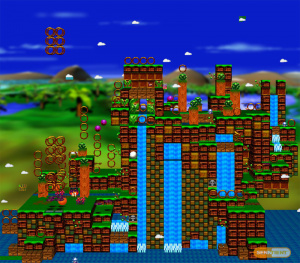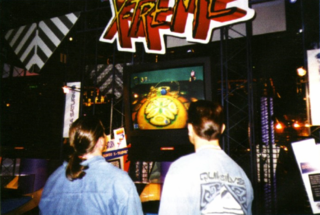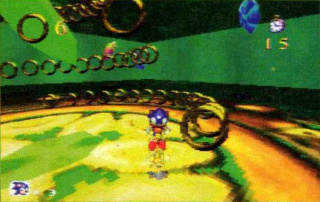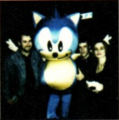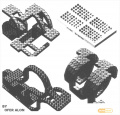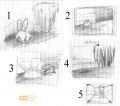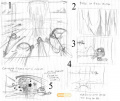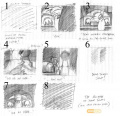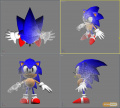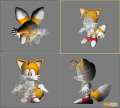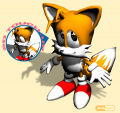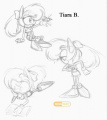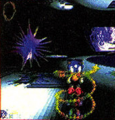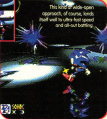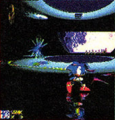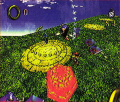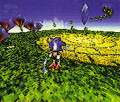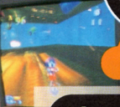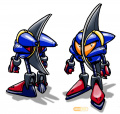Difference between revisions of "Sonic X-treme/Development"
From Sonic Retro
m (inline, quote) |
(→Development process: WIP) |
||
| Line 5: | Line 5: | ||
{{quote|1="Sonic Xtreme underwent many changes and difficulties that would have tested even the most seasoned game industry veterans. Lack of experience, poor business decisions, ego, politics, over-ambition, bad timing, poor communication... these were some of the ingredients that ultimately spelled disaster for the game. Bringing Sonic into 3D for the first time was a huge challenge - not only for gameplay, but from a technology standpoint as well. This made the job of defining what the game should be more difficult, but doubly so as the technology and platforms changed. In the first year and a half the team went through three programmers, causing the game’s technology to basically restart each time. Problems like this took a toll on the budget and created more pressure for the entire team down the line."|2=''Designer [[Chris Senn]]''|ref={{ref|https://web.archive.org/web/20110317064824/http://www.senntient.com:80/projects/xtreme/FAQ.html}}}} | {{quote|1="Sonic Xtreme underwent many changes and difficulties that would have tested even the most seasoned game industry veterans. Lack of experience, poor business decisions, ego, politics, over-ambition, bad timing, poor communication... these were some of the ingredients that ultimately spelled disaster for the game. Bringing Sonic into 3D for the first time was a huge challenge - not only for gameplay, but from a technology standpoint as well. This made the job of defining what the game should be more difficult, but doubly so as the technology and platforms changed. In the first year and a half the team went through three programmers, causing the game’s technology to basically restart each time. Problems like this took a toll on the budget and created more pressure for the entire team down the line."|2=''Designer [[Chris Senn]]''|ref={{ref|https://web.archive.org/web/20110317064824/http://www.senntient.com:80/projects/xtreme/FAQ.html}}}} | ||
| − | ===Saturn development=== | + | ====Saturn V08==== |
| + | Following the commercial failure of the [[32X]], the ''[[Sonic Mars]]'' project was being readied for a move to Sega's next-generation platform. A key component of [[Sega of America]]'s then-dispute with [[Sega of Japan]] was over the upcoming [[Sega Saturn]], as Western management had voiced a strong dislike of the console for some time, particularly in regards to its ability to stand up to the 3D capabilities of the {{SegaLink|Sony PlayStation}}.{{intref|Interview: Don Goddard (2008-05) by hxc}} This dislike was so strong that the company management had partnered with (and reportedly acquired a third of) [[wikipedia:Nvidia|Nvidia]], an American technology company specializing in [[wikipedia:graphics card|graphics cards]], for the development of an entirely new 32-bit system. Confusingly named the {{SegaLink|Saturn V08}} (also known by the name Riva TNT{{ref|https://web.archive.org/web/20230901082151/http://www.lostlevels.org/200403/200403-xtreme.shtml}}{{intref|Interview: Mike Wallis by Pachuka}} to distinguish it from the Japanese-developed Saturn{{intref|Interview: Don Goddard (2008-05) by hxc}}), management supported the platform move with both an increase in [[Sega Technical Institute]]'s on-hand staff and development resources. With the move off the 32X came a new working title for the game, this time signifying everything the new hardware power offered: '''''Sonic X-treme'''''.{{intref|Interview: Mike Wallis by Pachuka}} | ||
| + | |||
| + | The system was first introduced to [[STI]]'s tech director [[Robert Morgan]] for initial evaluations<ref>[[Mike Wallis]], ''[[Playing at the Next Level]]'', 2015-01-07 email interview by Ken Horowitz</ref>, and then presented as a potential "[[Sega Saturn|Saturn]]-killer" to the team by [[Roger Hector]] and a group of other executives. Unfortunately, the decision was made to first introduce the system to [[Ofer Alon]] alone. This conversation was accidentally overheard by [[Don Goddard]], who was bothered that he and his team were being left out of these initial discussions; something which directly led to his later departure from the company.{{intref|Interview: Don Goddard (2008-05) by hxc}} | ||
| + | |||
| + | Regardless, the system was described as being extremely capable at the kind of 3D rendering expected in the 32-bit era. Particularly, the technology featured the unique ability to morph polygon vertexes in-hardware for performance gains (meaning curved surfaces required less polygons to display), and even boasted built-in hardware colored lighting.{{intref|Interview: Don Goddard (2008-05) by hxc}} Ofer was very briefly tasked with evaluating the technical specifics of the system, and Goddard was developing experimental game prototypes for it (particularly the extensively-developed ''{{SegaLink|UFO}}'' demo), but integrating the technology's unique curved polygon capabilities into the existing graphics pipeline was reportedly a nightmare. During this time, the team never actually received any V08 documentation, solid technical specifications, or development hardware{{ref|https://web.archive.org/web/20230621013553/http://www.lostlevels.org/200403/timeline.shtml}}, resulting in challenges for those working with the proposed hardware, and a majority of the staff having little to work on in the interim.{{intref|Interview: Mike Wallis (2007-06-19) by Sega-16}} Despite this, management had supposed intentions of using the game as a launch title for the system.{{intref|Interview: Mike Wallis by Pachuka}} | ||
| + | |||
| + | This period only lasted for about three months{{ref|https://web.archive.org/web/20230621013553/http://www.lostlevels.org/200403/timeline.shtml}}, as other elements within Sega of America's management ultimately decided to decline in investing further in the platform. Nvidia did apparently manufacture a physical test version of the V08, but was significantly rushed. This was shipped to Sega of America in mid 1995, who installed the hardware and powered it on, only for it to instantly fail and display nothing more than a black screen. This failure, compounded with Sega of Japan's orders to halt the project{{intref|Interview: Mike Wallis by Pachuka}} , resulted in management reportedly dropping the V08 on the spot{{intref|Interview: Don Goddard (2008-05) by hxc}} (despite this, the chip would continue to be developed into the commercially-released {{SegaLink|NV1}} graphics card). Additionally, Goddard recalls that the video game industry industry was simply too used to rendering with standard triangles, and preferred more established techniques of building 3D shapes with standard polygons. This sentiment was mirrored by {{SegaLink|SegaSoft}} (STI's largest internal competitor who, as described by Goddard, was jealous of the division's unlimited funding).{{intref|Interview: Don Goddard (2008-05) by hxc}} Despite this, the final Saturn would utilize a complex rendering system not using triangles whatsoever. | ||
| + | |||
| + | During this time, Goddard and Alon had also been courted by another American technology company, [[wikipedia:3Dfx|3Dfx]], who promised a chip with the unique ability for development emulators to perform 1:1 with the final product, although nothing became of this.{{intref|Interview: Don Goddard (2008-05) by hxc}} Unfortunately, this only increased the amount of time the project wasted on alternative technology. Ultimately, with the cancellation of the V08 and Sega of Japan's order to transition to the actual [[Saturn]], Goddard was informed that all his work would again be going to waste. Upon hearing this, he quit the project, and a few months later in June 1995 quit Sega entirely.{{intref|Interview: Don Goddard (2008-05) by hxc}} This once again left the project without a team leader, and this time facing a 32-bit system more complex than any they had programmed for. | ||
| + | |||
| + | ===Saturn=== | ||
[[File:SonicXtremeJadeGullyScreenshot02.jpg|thumb|The layout to the first level in ''Sonic X-treme'', Jade Gully.]] | [[File:SonicXtremeJadeGullyScreenshot02.jpg|thumb|The layout to the first level in ''Sonic X-treme'', Jade Gully.]] | ||
| − | + | Following management moving the project to the [[Saturn]] in Fall 1995, the team was split into two groups: one group which would develop the "main branch" of the game, led by [[Ofer Alon]] and [[Chris Senn]], and a second solely dedicated to developing the game's boss rounds under the name ''[[Project Condor]]'', led by [[Christina Coffin]] using an engine from the ''[[Sonic Mars]]'' days.{{ref|https://web.archive.org/web/20230621013553/http://www.lostlevels.org/200403/timeline.shtml}} Both teams were supervised by [[Mike Wallis]]. A number of notable staff joined the project around this time, such as associate producer [[Rick Wheeler]]{{ref|https://web.archive.org/web/20110317064824/http://www.senntient.com:80/projects/xtreme/FAQ.html}} and 3D artist and animator [[Alan Ackerman]].{{ref|https://web.archive.org/web/20231001044804/http://alanackerman.blogspot.com/2012/01/alans-resume.html}} Despite previous claims, [[Sega of Japan]] did support the project in some capacity, as around this time, [[Hirokazu Yasuhara]] and [[Kunitake Aoki]] were enlisted to aid in development.{{intref|Interview: Chris Senn (2013-09-12) by Sega Addicts}} Management also attempted to foster a sense of camaraderie among the team by creating a series of promotional ''Sonic X-treme'' pins, which were awarded to the game's developers.{{intref|Interview: Don Goddard (2008-05) by hxc}} | |
| − | + | Unfortunately, the team was still struggling with design difficulties related to size and perspective in 3D environments{{intref|Interview: Mike Wallis (1996-05-04) by Game Players}}, and struggling with the concept of early 3D gameplay in general.{{magref|gameplayers|0906|39}} While the game's Zones were coming together, how Sonic would actually play in those Zones was still up in the air. In particular, the limited camera view in 3D games was a serious hindrance to gameplay, as it was difficult to maintain Sonic-like speeds while still being able to see upcoming obstacles and enemies. To solve this, Ofer Alon created the concept of the [[wikipedia:Fisheye lens|reflex lens]]{{magref|mms|45|26}}{{magref|segamagazin|32|6}}: gameplay would be presented with a "fisheye" perspective, distorting the screen to allow the camera to expand the visible play area.{{ref|https://web.archive.org/web/20110317064824/http://www.senntient.com:80/projects/xtreme/FAQ.html}}{{magref|gameplayers|0907|43}} While this did somewhat alleviate the issue of limited reaction time at high speeds, Goddard speculates the feature was a means to cover up the lack of true curved environments.{{intref|Interview: Don Goddard (2008-05) by hxc}} Regardless, the addition of the reflex lens sparked a much-needed sense of inspiration amongst the development team.{{magref|gameplayers|0907|43}} | |
| − | + | [[Christina Coffin]] served as lead programmer and designer of ''X-treme'''s boss rounds, which were created in an entirely new engine developed separately from the various iterations of the main game. As they were still learning how to program for the Saturn (compounded by the platform being notoriously hard to code for), development of the boss engine took longer than expected.{{intref|Interview: Don Goddard (2008-05) by hxc}} Still, much like [[Chris Senn]], Coffin's tenacity help keep the team's head above water, with her pulling double-duty as both programmer and designer. She worked alongside Jason Kuo, who designed the layout of the boss stages.{{intref|Interview: Mike Wallis by Pachuka}} According to [[Peter Morawiec]], Coffin and her boss engine team were largely tasked with "hacking together some quick demos" to appease company executives's expectations for its [[E3 1996]] appearance.{{intref|Interview: Peter Morawiec (2006-01-11) by hxc}} | |
| − | + | To create ''X-treme'''s boss arenas, Coffin drew inspiration from her passion playing [[Sega]] games. In particular, the engine's distinctive circular boss arenas were directly inspired by the Core Guard System fight in {{SegaLink|Treasure}}'s 1993 [[Mega Drive]] game ''{{SegaLink|Gunstar Heroes}}'', which features a similar circular layout. Coffin also took inspiration from the rendering engine used in ''[[NiGHTS into Dreams]]'' in her contrasting-colored backlights to keep Sonic from looking too flat{{ref|1=https://forums.sonicretro.org/index.php?threads/presenting.7325/page-3#post-128745}}, and the use of similar horizon-fogging techniques to mask uneven horizon lines.{{ref|https://forums.sonicretro.org/index.php?threads/presenting.7325/page-3#post-128838}} She attributes rumors of ''X-treme'' using [[Sonic Team]]'s actual engine to these similarities, definitively stating that she never used the ''NiGHTS'' engine, and clarifying that her and [[Yuji Naka]] did not see eye to eye during development.{{ref|https://forums.sonicretro.org/index.php?threads/presenting.7325/page-3#post-128745}} | |
| − | |||
| − | |||
| − | + | Coffin had intended her engine's [[Sonic the Hedgehog|Sonic]] to be represented by a fully 3D model. Models of the character were created by [[Kunitake Aoki]] during his work on ''{{SegaLink|Dynamite Deka}}''{{ref|1=https://forums.sonicretro.org/index.php?threads/presenting.7325/page-3#post-128836}}, and were implemented by Coffin to take advantage of what she calls a quad bug, "where if you collapse opposite points of a saturn quad you get a triangle with one edge that's collapsed in and smoothly concave in screenspace at the pixel level."{{ref|1=https://forums.sonicretro.org/index.php?threads/presenting.7325/page-3#post-128745}} Coffin would utilize this "bug" to demonstrate how enemies can only be safely attacked from certain angles, and for rendering terrain hazards like spike pits.{{ref|1=https://forums.sonicretro.org/index.php?threads/presenting.7325/page-5#post-128926}} | |
| − | + | It was during this phase of development (once ''X-treme'' became "real" on the Saturn) that [[Sega of America]] began its marketing push for the game. Among these was a largely Sega-authored series of three promotional articles in ''{{SegaLink|Game Players}}'' magazines titled ''Sonic's Red Shoe Diaries''. While the series did provide some valuable insight into the game's development (including photographs of STI's studio and team members), Senn recalls the articles were written before the team even had much to show, and had the unintended effect of increasing the cycle of marketing hype and added to the team's already-mounting [[E3 1996]] stresses.{{intref|Interview: Peter Morawiec (2006-01-11) by hxc}}{{fileref|ElectronicGamingMonthlyUnknownIssue2.gif}} | |
| − | + | Thankfully, Alon's gameplay engine (which the main branch team was using to construct its worlds) was extensively programmed and well-considered. Originally developed for [[Macintosh]] computers{{intref|Interview: Peter Morawiec (2006-01-11) by hxc}} over the course of about a year (with extensive input from Senn) and then ported to [[Windows 95]] for use by other STI developers, the editor soon found itself being used by a great number of the team's staff. It also boasted an extensive feature list, such as the reflex lens, the ability to rotate the world at specific points in the stage, and "dynamic spline paths" which would locks players into a winding, high-speed path (a means of maintaining traditional 2D ''[[Sonic the Hedgehog]]'' speed with the limited 3D camera).{{ref|http://www.lostlevels.org/200403/200403-xtreme.shtml}} However, as it was being frequently updated, it was sometimes difficult to teach, with only Alon, Senn, and Rick Wheeler knowing the program in its entirety.{{ref|https://web.archive.org/web/20110317064824/http://www.senntient.com:80/projects/xtreme/FAQ.html}} Reportedly, Alon's engine was built with so much consideration that it was designed to be used in future projects.{{ref|https://web.archive.org/web/20110317064824/http://www.senntient.com:80/projects/xtreme/FAQ.html}} ''{{SegaLink|Game Players}}'' magazine claimed Alon's tools were considered for use in a potential ''X-treme'' follow-up{{magref|gameplayers|0909|54}}, but this never came to pass. | |
| − | + | ===Point of View=== | |
| + | {{quote|1="Somewhere between six and eight months prior to the project’s cancellation, management had investigated outside options to help insure completion of the game. They chose a company called ‘POV’. The effort was led by the Technical Director Robert Morgan, one of the original founders of POV, without the knowledge of Ofer Alon (or Christian Senn). When ready, management brought both Ofer and Senn into an office and unveiled their new plan to finish the game. The plan included removing Ofer as technical lead of the project and shifting technical control over to Robert Morgan, who would lead POV. Management presented POV’s efforts on-screen which included a computer monitor with an animating Sonic sprite fixed on-screen, a ground plane with a checkerboard texture on it, and a shaded sphere floating in the sky - without interaction of any kind."|2=''Designer [[Chris Senn]]''|ref={{ref|https://web.archive.org/web/20110317064824/http://www.senntient.com:80/projects/xtreme/FAQ.html}}}} | ||
| + | |||
| + | Around early 1996, [[STI]] tech director [[Robert Morgan]] took [[Ofer Alon]]'s engine and tools to [[Point of View]], a company co-founded that same year by Morgan, in an attempt to get the engine's Saturn output to render at a playable framerate. Unfortunately, this was done entirely without either Alon or [[Chris Senn]]'s knowledge. Senn remembers the two being called into a meeting in Morgan's office, where they learned of these efforts for the first time. A company security guard was posted outside the meeting, with someone in management considering the possibility that Alon would grow violent upon hearing he was being replaced as lead programmer; Morgan would now be assuming that role, with Alon demoted to a regular programmer. Senn considered this both backstabbing and drastic. To make things worse, their "hope" for the project's success was demonstrated to the two as a demonstration ROM provided by Point of View. "They showed us the Sonic sprite we were already using floating in the upper-right of the screen, a checkerboard ground, a rotating shaded polygonal shape floating in the air and maybe a ring sprite animating." Sensing the pair's astonishment, a Sega of America representative attempted to frame the unimpressive demo as the start of something larger, saying "we're on a mission [to]...", at which point they were interrupted by Alon, who said "have a nice trip" and walked out of the meeting.{{ref|https://web.archive.org/web/20110317064824/http://www.senntient.com:80/projects/xtreme/FAQ.html}} | ||
| + | |||
| + | All of this deeply insulted an already-overworked Alon, who was dedicating incredible hours on getting his engine to where it was, only for it to be disregarded so easily. While management tried to justify the plan by framing it as simply utilizing Point of View to port Ofer's work to the Saturn, Senn feels this "trivialized the complexity of Ofer's technology and proved there was a very different understanding of what was involved to port the existing technology." Adding insult to injury was management's insistence on referring to Alon as "just another programmer", despite him having created ''X-treme'''s engine, level editor, reflex lens, and world rotation features, among others. Senn believes Ofer was held to unfair expectations, being hyped up by [[Roger Hector]] (as an apparent [[wikipedia:MENSA|MENSA]] genius) and being expensive to hire, alongside choosing to work from home later in the project; he attributes this to Alon's preference of isolating himself as a programmer to avoid distractions. Despite maintaining a consistent 16 hours a day, 7 day a week workweek dedicated solely to coding for the game, Senn thinks management likely viewed his absence from STI's offices as either laziness or vacationing - a treatment which would directly lead to Alon's later departure from Sega.{{ref|https://web.archive.org/web/20110317064824/http://www.senntient.com:80/projects/xtreme/FAQ.html}} It was even rumored that Morgan withheld a development kit Ofer needed to translate his PC work to the Saturn, so that Ofer would "fail", and Robert could use a company that he co-founded to become the "savior" of the project{{ref|https://web.archive.org/web/20110317064824/http://www.senntient.com:80/projects/xtreme/FAQ.html}} | ||
| + | |||
| + | ===''Project Condor''=== | ||
| + | In March 1996, [[Shoichiro Irimajiri]] (a head [[Sega of Japan]] executive) visited [[Sega Technical Institute]], where Wallis and the team demonstrate their progress on the game's Point of View Software branch.{{ref|https://web.archive.org/web/20110317064824/http://www.senntient.com:80/projects/xtreme/FAQ.html}} Unfortunately, he is very disappointed with the state ''X-treme'' is in, reportedly "outraged to see how much was left to be done."{{ref|http://www.lostlevels.org/200403/200403-xtreme.shtml}} However, before he leaves, he is also shown ''Project Condor'', which he likes, requesting the entire game be remade in Coffin's engine.{{ref|https://web.archive.org/web/20230621013553/http://www.lostlevels.org/200403/timeline.shtml}} Alon/Senn's ''SonicPC'' was reportedly in a demonstrable state by Irimajiri's visit, but because he was already so disappointed, Senn got cold feet and failed to bring it up before the executive's departure.{{ref|https://web.archive.org/web/20110317064824/http://www.senntient.com:80/projects/xtreme/FAQ.html}} By the time Alon had caught up with the group, PC motherboard slung under his arm, Irimajiri had already left.{{ref|https://web.archive.org/web/20110317064824/http://www.senntient.com:80/projects/xtreme/FAQ.html}} With this, Point of View's was dropped from the project{{ref|https://web.archive.org/web/20110317064824/http://www.senntient.com:80/projects/xtreme/FAQ.html}}, and all official development on the game was moved over to Coffin's boss engine: ''[[Project Condor]]''. | ||
| + | |||
| + | {{quote|1="I went to the exec producer and VP and told them the only way we had any semblance of hope of finishing this game for Christmas was to give me the reins, get rid of the political crap, isolate a core team, and give us the tools necessary to get the job done. SOA/STI management agreed, we pulled a core group of 4 artists, 2 programmers (+ 1 contractor), and 3 designers into the old STI location and we get to work."|2=''Producer [[Mike Wallis]]''|ref={{ref|https://web.archive.org/web/20230621013553/http://www.lostlevels.org/200403/timeline.shtml}}}} | ||
| + | |||
| + | The project appears to have gained its official nickname during this time: '''''Project Condor'''''. While seemingly always known under that name, artist [[Ross Harris]] also decided to create a placeholder title screen by the name '''''Sonic Saturn'''''. [[Chris Coffin]] clarifies this was purely done on a whim, and was not a working title for the game; only meant to represent Sonic's appearance on the [[Saturn]]{{ref|1=https://forums.sonicretro.org/index.php?threads/presenting.7325/page-4#post-128889}} (and equally unrelated to [[STI Burbank]]'s ''[[Sonic Saturn]]''). Still, even with the project's talent consolidated on a single task, the Christmas deadline was about half a year away. As a result, Coffin was often left to work alone on her programming for long times, dedicating herself to making that deadline. During her experimentation with ''Condor'', she tested the game with the {{SegaLink|3D Analog Pad}}, and it reportedly played "so much better." She pushed for the game to require the controller, but this idea does not seem to have panned out.{{ref|1=https://forums.sonicretro.org/index.php?threads/presenting.7325/page-4#post-128847}} She also recalls never seriously looking into {{SegaLink|RAM Cartridge}} support due to the project's already-tight schedule. | ||
| + | |||
| + | Four bosses were programmed for ''Condor'': [[Fang the Sniper]], [[Metal Sonic|Mecha Sonic]] (actually [[Metal Sonic]]), an "evil Sonic clone", and an unnamed fourth boss. These first three had reasonably-polished AI before the game's cancellation with Fang's stage even featuring mushroom [[Spring]]s from [[Mushroom Hill Zone]].{{fileref|SonicXtreme Condor SAT Fang1.png}} The fourth, described by Coffin as a "dumb" AI which operated similar to simple boss fights from earlier ''[[Sonic the Hedgehog]]'' games, required fewer resources and ran more smoothly.{{ref|1=https://forums.sonicretro.org/index.php?threads/presenting.7325/page-4#post-128847}} This boss appears to have taken the form of the green gemstone fight playable at [[E3 1996]]. These bosses all all notably larger than Sonic, particularly in regard to Mecha Sonic; this was done not only because seeing such large characters was considered impressive, but that the increased size made the bosses easier to hit for players potentially inexperienced with 3D gameplay.{{ref|https://web.archive.org/web/20110317064824/http://www.senntient.com:80/projects/xtreme/FAQ.html}} | ||
| + | |||
| + | ''Condor'' uses the {{SegaLink|Sega Graphics Library}}, which the game was running on for its playable appearance at [[E3 1996]]{{intref|Interview: Mike Wallis (1996-06-20) by Sega Saturn Magazine (UK)}}{{magref|maximum|7|73}} Its appearance at the show used baked-in{{ref|1=https://forums.sonicretro.org/index.php?threads/presenting.7325/page-5#post-130552}} gourad light-sourcing{{ref|1=https://forums.sonicretro.org/index.php?threads/presenting.7325/page-3#post-128745}}{{magref|gameplayers|0909|55}}, something considered quite an achievement for the time. This effect is most notable when boss characters throw a projectile (such as [[Fang the Sniper]]'s grenade){{ref|1=https://forums.sonicretro.org/index.php?threads/presenting.7325/page-5#post-130552}}, and as pointed out by Coffin herself, is a feature notably absent from the earliest versions of the engine shown to the press. | ||
| + | |||
| + | Coffin designed her engine to be largely modular and tweakable on the fly, specifically to combat the slow speed of traditionally using a CD emulator. As a result, much of the project's testing was not done on CD (instead run directly from development hardware), and the version of ''Condor'' publicly dumped in 2016 is a "very old tester app" described nothing more as a sandbox for Sonic to run around in.{{ref|1=https://forums.sonicretro.org/index.php?threads/presenting.7325/page-3#post-128838}} | ||
| + | |||
| + | Around April 1996, [[Bernie Stolar]] was hired by the company and becomes CEO of [[Sega of America]]. Learning of the troubled ''X-treme'' project, he met with [[Roger Hector]] and requested that he isolate the best of [[Sega Technical Institute]], provide them with all the resources they need, and have them focus on nothing but completing the game. As part of this process, he visited STI and spoke directly with Wallis, who told him the only semblance of hope for finishing ''X-treme'' by Christmas was to give Wallis the control he previously lacked as a producer and eliminate the political issues restraining development. Management agreed, and together, a core group of staff was chosen and moved into [[Sega Technical Institute]]'s former offices at 255 Redwood Shores{{ref|https://web.archive.org/web/20230621013553/http://www.lostlevels.org/200403/timeline.shtml}}, where they were provided food and sleeping material in preparation for their daily 15-16 hour shifts.{{intref|Interview: Mike Wallis by Pachuka}} | ||
| + | |||
| + | During Stolar's initial exchange with STI, Wallis consulted with the development team for possible ideas to improve development, and it is determined that the gameplay engine from [[Sonic Team]]'s ''[[NiGHTS into Dreams]]'' would be extremely beneficial to completing the game by Christmas, particularly in the time saved by not having to create their own development tools.{{intref|Interview: Mike Wallis by Pachuka}} Following this, the team received "some editors", and shortly after, "the engine code" for ''NiGHTS''. After two weeks of the team familiarizing themselves with the tools, Stolar returns to STI and informs Wallis that Sega of Japan (specifically [[Yuji Naka]]) forbade them from using Sonic Team's code, with Naka threatening to quit if they were allowed to proceed. Left without a choice, the team acquiesces to this request, and an additional two to three weeks of development are wasted.{{ref|https://web.archive.org/web/20230621013553/http://www.lostlevels.org/200403/timeline.shtml}} | ||
| + | |||
| + | Curiously, several sources indicate the development team did not actually receive the ''NiGHTS'' engine after all. The primary source for this claim, Mike Wallis, has recalled a different explanation in each of his three interviews on the subject, with one even claiming that Yuji Naka only threatened to quit IF they received his engine.{{intref|Interview: Mike Wallis by Pachuka}} Another statement of his claims Sega of Japan did promise to actually deliver the requested tools, but later pulled the request. Naka himself has chimed in on this, recalling he does not remember such a request, and even if it had been made, the extreme complexity of the ''NiGHTS'' engine would have made it nearly impossible to port by a team inexperienced with the code. This confusion likely stemmed from magazine articles comparing the similarity of the game to ''Project Condor''{{intref|Interview: Mike Wallis (1996-06-20) by Sega Saturn Magazine (UK)}}{{fileref|SonicXtremeUnknownFrenchArticle.jpg}}, and the fact that both are running on the same underlying {{SegaLink|Sega Graphics Library}} code.{{magref|gameplayers|0909|55}} Both Coffin{{ref|https://forums.sonicretro.org/index.php?threads/presenting.7325/page-3#post-128745}} and Senn have definitively refuted the claim, with the latter clarifying "No. This was discussed at one point, but never became a reality. The Boss engine Christina Coffin created provided a similar look, albeit simpified, to the NiGHTS engine, but the actual engine was never shared or used."{{ref|https://web.archive.org/web/20230621013553/http://www.lostlevels.org/200403/timeline.shtml}} Regardless, the team did not get access to the development tools they were seeking, and began developing their own tools from scratch.{{intref|Interview: Mike Wallis by Pachuka}} Further, May 1996 saw the team streamlined once again, removing 1/3 of the staff and placing even more responsibilities on Chris Senn's shoulders.{{ref|http://www.lostlevels.org/200403/200403-xtreme.shtml}} | ||
| + | |||
| + | ===''SonicPC''=== | ||
| + | In response to the insult of [[Robert Morgan]] and [[Point of View]]'s earlier intervention in their work, Alon and Senn had made the decision to get together and continue development of Ofer's engine by themselves, intending to show up Morgan's version of the game and prove management's error firsthand.{{ref|https://web.archive.org/web/20110317064824/http://www.senntient.com:80/projects/xtreme/FAQ.html}} This led Alon to work feverishly on expanding his editor, but only on his iteration: both Sega Technical Institute and Point of View were stuck using an older, simpler version of both the gameplay engine and level editor programs, with STI in particular continuing to build stages with "a very rudimentary version ... based on an old version of Ofer's editor".{{ref|https://web.archive.org/web/20110317064824/http://www.senntient.com:80/projects/xtreme/FAQ.html}}{{ref|http://www.lostlevels.org/200403/200403-xtreme.shtml}} This is particularly notable in Point of View's version, as the company was unable to achieve the game's trademark reflex lens.{{ref|https://web.archive.org/web/20110317064824/http://www.senntient.com:80/projects/xtreme/FAQ.html}} Alon and Senn would continue working on this PC-based version alongside their main work within STI, where it would eventually gain the name ''[[SonicPC]]''{{ref|https://web.archive.org/web/20110317064824/http://www.senntient.com:80/projects/xtreme/FAQ.html}} | ||
| + | |||
| + | Around this time, work on Alon and Senn's private PC version of the game, ''SonicPC'', was being readied for demonstration. The pair cleaned up four levels, placed enemies and obstacles, and pitched the concept to {{SegaLink|SegaSoft}} head {{SegaLink|Greg Suarez}}. Unfortunately, he refused to invest money in the project, as the division was usually only comfortable with ports of existing games{{intref|Interview: Mike Wallis by Pachuka}}, with Senn speculating that Irimajiri's request to see everything moved to ''Project Condor'' may have played a motivating factor as well.{{ref|https://web.archive.org/web/20110317064824/http://www.senntient.com:80/projects/xtreme/FAQ.html}} With this, ''SonicPC'' was officially canned, leaving Senn's levels 60% complete at best, with the designer estimating it would have taken the pair about six months to produce a completed game.{{ref|https://web.archive.org/web/20110317064824/http://www.senntient.com:80/projects/xtreme/FAQ.html}} Due to this, and because of frustration suffered from his frequent mistreatment by management, Alon left the company around July or August 1996, leaving Senn as one of few core developers left on the project. | ||
| + | |||
| + | ===Decline and cancellation=== | ||
| + | To handle the new workload resulting from Alon's departure, Senn permanently moved out of his apartment, stored all his belongings in a company storeroom, and physically moved into the old STI offices directly besides ''Condor'' (located at 255 Redwood Shores{{intref|Interview: Mike Wallis by Pachuka}}), all in an attempt to migrate older work into Coffin's engine by Christmas.{{ref|https://web.archive.org/web/20230621013553/http://www.lostlevels.org/200403/timeline.shtml}} While officially working separately from the ''Condor'' team, Senn was literally working next door to their office, and was able to visit them in-person whenever necessary. Around this time, the main game's Acts were nearing 80% completion.{{ref|https://web.archive.org/web/20230621013553/http://www.lostlevels.org/200403/timeline.shtml}} | ||
| + | |||
| + | Unfortunately, the overburdening of ''X-treme''<nowiki>'</nowiki>s lead developers had finally caught up with the project. ''Condor''<nowiki>'</nowiki>s lead programmer, [[Christina Coffin]], grew desperately ill from overwork and was forced to duck out of the project late in development. Even worse, [[Chris Senn]] developed a terrible pneumonia, but continued to work as much as he possibly could until informed that his health was literally failing. "I took on far more than was healthy... and after 2 years I became extremely ill... a nurse told me he thought I had 6 months to live, actually. I lost 25 pounds, was sick all the time, had cramps... and still went in to work... all due to too much stress." During this era, he recalls spending much of his non-working time vomiting or incapacitated, and a Spring 1996 photograph (taken for ''{{SegaLink|Game Players}}''' ''Red Shoe Diaries'') reveals his limbs had grown nearly emaciated by the end of development.{{ref|https://web.archive.org/web/20110317064824/http://www.senntient.com:80/projects/xtreme/FAQ.html}} Shocked at how badly and how quickly their conditions worsened, Wallis informed management that the project could not continue, and the game would not make Christmas. With this, ''Sonic X-treme'' was cancelled.{{ref|https://web.archive.org/web/20110317064824/http://www.senntient.com:80/projects/xtreme/FAQ.html}} | ||
| + | |||
| + | The following August, Stolar revealed that he had been working on an enhanced [[Saturn]] port of ''[[Sonic 3D: Flickies' Island]]'' as a backup strategy should ''X-treme'' fail{{intref|Interview: Mike Wallis by Pachuka}}, and offered to make Wallis a producer on the game. This offer was accepted, with Wallis going on to manage development teams in the United States, Japan, and Europe to release the Saturn version later that October.{{ref|https://web.archive.org/web/20230621013553/http://www.lostlevels.org/200403/timeline.shtml}} However, a later Wallis interview contradicts this, instead claiming the Saturn version of ''Flickies' Island'' was already in development and is unrelated.{{intref|Interview: Mike Wallis (2007-06-19) by Sega-16}} | ||
| + | |||
| + | Following ''X-treme'''s cancellation, Coffin returned to {{SegaLink|Developer Technical Assistance}}, where the discoveries she made during the development of ''Condor'' were passed onto the division and implemented in the development of a number of later [[Saturn]] games, such as ''[[Burning Rangers]]''.{{ref|1=https://forums.sonicretro.org/index.php?threads/presenting.7325/page-3#post-128797}} A Sega of America representative also claimed that certain design ideas and art went on to inspire elements of ''[[Sonic R]]'', but did not clarify which.{{fileref|GameProUnknownIssuePage42.jpg}} | ||
<gallery> | <gallery> | ||
| Line 34: | Line 81: | ||
SonicXtreme devteam Spring1996 chart.png|Stage concept flowchart | SonicXtreme devteam Spring1996 chart.png|Stage concept flowchart | ||
</gallery> | </gallery> | ||
| − | |||
| − | |||
| − | |||
| − | |||
| − | |||
| − | |||
| − | |||
==Prerelease== | ==Prerelease== | ||
Revision as of 22:26, 19 December 2023
- Back to: Sonic X-treme.
Contents
Development process
| “ | "Sonic Xtreme underwent many changes and difficulties that would have tested even the most seasoned game industry veterans. Lack of experience, poor business decisions, ego, politics, over-ambition, bad timing, poor communication... these were some of the ingredients that ultimately spelled disaster for the game. Bringing Sonic into 3D for the first time was a huge challenge - not only for gameplay, but from a technology standpoint as well. This made the job of defining what the game should be more difficult, but doubly so as the technology and platforms changed. In the first year and a half the team went through three programmers, causing the game’s technology to basically restart each time. Problems like this took a toll on the budget and created more pressure for the entire team down the line." | „ |
| — Designer Chris Senn[1] | ||
Saturn V08
Following the commercial failure of the 32X, the Sonic Mars project was being readied for a move to Sega's next-generation platform. A key component of Sega of America's then-dispute with Sega of Japan was over the upcoming Sega Saturn, as Western management had voiced a strong dislike of the console for some time, particularly in regards to its ability to stand up to the 3D capabilities of the Sony PlayStation.[2] This dislike was so strong that the company management had partnered with (and reportedly acquired a third of) Nvidia, an American technology company specializing in graphics cards, for the development of an entirely new 32-bit system. Confusingly named the Saturn V08 (also known by the name Riva TNT[3][4] to distinguish it from the Japanese-developed Saturn[2]), management supported the platform move with both an increase in Sega Technical Institute's on-hand staff and development resources. With the move off the 32X came a new working title for the game, this time signifying everything the new hardware power offered: Sonic X-treme.[4]
The system was first introduced to STI's tech director Robert Morgan for initial evaluations[5], and then presented as a potential "Saturn-killer" to the team by Roger Hector and a group of other executives. Unfortunately, the decision was made to first introduce the system to Ofer Alon alone. This conversation was accidentally overheard by Don Goddard, who was bothered that he and his team were being left out of these initial discussions; something which directly led to his later departure from the company.[2]
Regardless, the system was described as being extremely capable at the kind of 3D rendering expected in the 32-bit era. Particularly, the technology featured the unique ability to morph polygon vertexes in-hardware for performance gains (meaning curved surfaces required less polygons to display), and even boasted built-in hardware colored lighting.[2] Ofer was very briefly tasked with evaluating the technical specifics of the system, and Goddard was developing experimental game prototypes for it (particularly the extensively-developed UFO demo), but integrating the technology's unique curved polygon capabilities into the existing graphics pipeline was reportedly a nightmare. During this time, the team never actually received any V08 documentation, solid technical specifications, or development hardware[6], resulting in challenges for those working with the proposed hardware, and a majority of the staff having little to work on in the interim.[7] Despite this, management had supposed intentions of using the game as a launch title for the system.[4]
This period only lasted for about three months[6], as other elements within Sega of America's management ultimately decided to decline in investing further in the platform. Nvidia did apparently manufacture a physical test version of the V08, but was significantly rushed. This was shipped to Sega of America in mid 1995, who installed the hardware and powered it on, only for it to instantly fail and display nothing more than a black screen. This failure, compounded with Sega of Japan's orders to halt the project[4] , resulted in management reportedly dropping the V08 on the spot[2] (despite this, the chip would continue to be developed into the commercially-released NV1 graphics card). Additionally, Goddard recalls that the video game industry industry was simply too used to rendering with standard triangles, and preferred more established techniques of building 3D shapes with standard polygons. This sentiment was mirrored by SegaSoft (STI's largest internal competitor who, as described by Goddard, was jealous of the division's unlimited funding).[2] Despite this, the final Saturn would utilize a complex rendering system not using triangles whatsoever.
During this time, Goddard and Alon had also been courted by another American technology company, 3Dfx, who promised a chip with the unique ability for development emulators to perform 1:1 with the final product, although nothing became of this.[2] Unfortunately, this only increased the amount of time the project wasted on alternative technology. Ultimately, with the cancellation of the V08 and Sega of Japan's order to transition to the actual Saturn, Goddard was informed that all his work would again be going to waste. Upon hearing this, he quit the project, and a few months later in June 1995 quit Sega entirely.[2] This once again left the project without a team leader, and this time facing a 32-bit system more complex than any they had programmed for.
Saturn
Following management moving the project to the Saturn in Fall 1995, the team was split into two groups: one group which would develop the "main branch" of the game, led by Ofer Alon and Chris Senn, and a second solely dedicated to developing the game's boss rounds under the name Project Condor, led by Christina Coffin using an engine from the Sonic Mars days.[6] Both teams were supervised by Mike Wallis. A number of notable staff joined the project around this time, such as associate producer Rick Wheeler[1] and 3D artist and animator Alan Ackerman.[8] Despite previous claims, Sega of Japan did support the project in some capacity, as around this time, Hirokazu Yasuhara and Kunitake Aoki were enlisted to aid in development.[9] Management also attempted to foster a sense of camaraderie among the team by creating a series of promotional Sonic X-treme pins, which were awarded to the game's developers.[2]
Unfortunately, the team was still struggling with design difficulties related to size and perspective in 3D environments[10], and struggling with the concept of early 3D gameplay in general.[11] While the game's Zones were coming together, how Sonic would actually play in those Zones was still up in the air. In particular, the limited camera view in 3D games was a serious hindrance to gameplay, as it was difficult to maintain Sonic-like speeds while still being able to see upcoming obstacles and enemies. To solve this, Ofer Alon created the concept of the reflex lens[12][13]: gameplay would be presented with a "fisheye" perspective, distorting the screen to allow the camera to expand the visible play area.[1][14] While this did somewhat alleviate the issue of limited reaction time at high speeds, Goddard speculates the feature was a means to cover up the lack of true curved environments.[2] Regardless, the addition of the reflex lens sparked a much-needed sense of inspiration amongst the development team.[14]
Christina Coffin served as lead programmer and designer of X-treme's boss rounds, which were created in an entirely new engine developed separately from the various iterations of the main game. As they were still learning how to program for the Saturn (compounded by the platform being notoriously hard to code for), development of the boss engine took longer than expected.[2] Still, much like Chris Senn, Coffin's tenacity help keep the team's head above water, with her pulling double-duty as both programmer and designer. She worked alongside Jason Kuo, who designed the layout of the boss stages.[4] According to Peter Morawiec, Coffin and her boss engine team were largely tasked with "hacking together some quick demos" to appease company executives's expectations for its E3 1996 appearance.[15]
To create X-treme's boss arenas, Coffin drew inspiration from her passion playing Sega games. In particular, the engine's distinctive circular boss arenas were directly inspired by the Core Guard System fight in Treasure's 1993 Mega Drive game Gunstar Heroes, which features a similar circular layout. Coffin also took inspiration from the rendering engine used in NiGHTS into Dreams in her contrasting-colored backlights to keep Sonic from looking too flat[16], and the use of similar horizon-fogging techniques to mask uneven horizon lines.[17] She attributes rumors of X-treme using Sonic Team's actual engine to these similarities, definitively stating that she never used the NiGHTS engine, and clarifying that her and Yuji Naka did not see eye to eye during development.[16]
Coffin had intended her engine's Sonic to be represented by a fully 3D model. Models of the character were created by Kunitake Aoki during his work on Dynamite Deka[18], and were implemented by Coffin to take advantage of what she calls a quad bug, "where if you collapse opposite points of a saturn quad you get a triangle with one edge that's collapsed in and smoothly concave in screenspace at the pixel level."[16] Coffin would utilize this "bug" to demonstrate how enemies can only be safely attacked from certain angles, and for rendering terrain hazards like spike pits.[19]
It was during this phase of development (once X-treme became "real" on the Saturn) that Sega of America began its marketing push for the game. Among these was a largely Sega-authored series of three promotional articles in Game Players magazines titled Sonic's Red Shoe Diaries. While the series did provide some valuable insight into the game's development (including photographs of STI's studio and team members), Senn recalls the articles were written before the team even had much to show, and had the unintended effect of increasing the cycle of marketing hype and added to the team's already-mounting E3 1996 stresses.[15][20]
Thankfully, Alon's gameplay engine (which the main branch team was using to construct its worlds) was extensively programmed and well-considered. Originally developed for Macintosh computers[15] over the course of about a year (with extensive input from Senn) and then ported to Windows 95 for use by other STI developers, the editor soon found itself being used by a great number of the team's staff. It also boasted an extensive feature list, such as the reflex lens, the ability to rotate the world at specific points in the stage, and "dynamic spline paths" which would locks players into a winding, high-speed path (a means of maintaining traditional 2D Sonic the Hedgehog speed with the limited 3D camera).[21] However, as it was being frequently updated, it was sometimes difficult to teach, with only Alon, Senn, and Rick Wheeler knowing the program in its entirety.[1] Reportedly, Alon's engine was built with so much consideration that it was designed to be used in future projects.[1] Game Players magazine claimed Alon's tools were considered for use in a potential X-treme follow-up[22], but this never came to pass.
Point of View
| “ | "Somewhere between six and eight months prior to the project’s cancellation, management had investigated outside options to help insure completion of the game. They chose a company called ‘POV’. The effort was led by the Technical Director Robert Morgan, one of the original founders of POV, without the knowledge of Ofer Alon (or Christian Senn). When ready, management brought both Ofer and Senn into an office and unveiled their new plan to finish the game. The plan included removing Ofer as technical lead of the project and shifting technical control over to Robert Morgan, who would lead POV. Management presented POV’s efforts on-screen which included a computer monitor with an animating Sonic sprite fixed on-screen, a ground plane with a checkerboard texture on it, and a shaded sphere floating in the sky - without interaction of any kind." | „ |
| — Designer Chris Senn[1] | ||
Around early 1996, STI tech director Robert Morgan took Ofer Alon's engine and tools to Point of View, a company co-founded that same year by Morgan, in an attempt to get the engine's Saturn output to render at a playable framerate. Unfortunately, this was done entirely without either Alon or Chris Senn's knowledge. Senn remembers the two being called into a meeting in Morgan's office, where they learned of these efforts for the first time. A company security guard was posted outside the meeting, with someone in management considering the possibility that Alon would grow violent upon hearing he was being replaced as lead programmer; Morgan would now be assuming that role, with Alon demoted to a regular programmer. Senn considered this both backstabbing and drastic. To make things worse, their "hope" for the project's success was demonstrated to the two as a demonstration ROM provided by Point of View. "They showed us the Sonic sprite we were already using floating in the upper-right of the screen, a checkerboard ground, a rotating shaded polygonal shape floating in the air and maybe a ring sprite animating." Sensing the pair's astonishment, a Sega of America representative attempted to frame the unimpressive demo as the start of something larger, saying "we're on a mission [to]...", at which point they were interrupted by Alon, who said "have a nice trip" and walked out of the meeting.[1]
All of this deeply insulted an already-overworked Alon, who was dedicating incredible hours on getting his engine to where it was, only for it to be disregarded so easily. While management tried to justify the plan by framing it as simply utilizing Point of View to port Ofer's work to the Saturn, Senn feels this "trivialized the complexity of Ofer's technology and proved there was a very different understanding of what was involved to port the existing technology." Adding insult to injury was management's insistence on referring to Alon as "just another programmer", despite him having created X-treme's engine, level editor, reflex lens, and world rotation features, among others. Senn believes Ofer was held to unfair expectations, being hyped up by Roger Hector (as an apparent MENSA genius) and being expensive to hire, alongside choosing to work from home later in the project; he attributes this to Alon's preference of isolating himself as a programmer to avoid distractions. Despite maintaining a consistent 16 hours a day, 7 day a week workweek dedicated solely to coding for the game, Senn thinks management likely viewed his absence from STI's offices as either laziness or vacationing - a treatment which would directly lead to Alon's later departure from Sega.[1] It was even rumored that Morgan withheld a development kit Ofer needed to translate his PC work to the Saturn, so that Ofer would "fail", and Robert could use a company that he co-founded to become the "savior" of the project[1]
Project Condor
In March 1996, Shoichiro Irimajiri (a head Sega of Japan executive) visited Sega Technical Institute, where Wallis and the team demonstrate their progress on the game's Point of View Software branch.[1] Unfortunately, he is very disappointed with the state X-treme is in, reportedly "outraged to see how much was left to be done."[21] However, before he leaves, he is also shown Project Condor, which he likes, requesting the entire game be remade in Coffin's engine.[6] Alon/Senn's SonicPC was reportedly in a demonstrable state by Irimajiri's visit, but because he was already so disappointed, Senn got cold feet and failed to bring it up before the executive's departure.[1] By the time Alon had caught up with the group, PC motherboard slung under his arm, Irimajiri had already left.[1] With this, Point of View's was dropped from the project[1], and all official development on the game was moved over to Coffin's boss engine: Project Condor.
| “ | "I went to the exec producer and VP and told them the only way we had any semblance of hope of finishing this game for Christmas was to give me the reins, get rid of the political crap, isolate a core team, and give us the tools necessary to get the job done. SOA/STI management agreed, we pulled a core group of 4 artists, 2 programmers (+ 1 contractor), and 3 designers into the old STI location and we get to work." | „ |
| — Producer Mike Wallis[6] | ||
The project appears to have gained its official nickname during this time: Project Condor. While seemingly always known under that name, artist Ross Harris also decided to create a placeholder title screen by the name Sonic Saturn. Chris Coffin clarifies this was purely done on a whim, and was not a working title for the game; only meant to represent Sonic's appearance on the Saturn[23] (and equally unrelated to STI Burbank's Sonic Saturn). Still, even with the project's talent consolidated on a single task, the Christmas deadline was about half a year away. As a result, Coffin was often left to work alone on her programming for long times, dedicating herself to making that deadline. During her experimentation with Condor, she tested the game with the 3D Analog Pad, and it reportedly played "so much better." She pushed for the game to require the controller, but this idea does not seem to have panned out.[24] She also recalls never seriously looking into RAM Cartridge support due to the project's already-tight schedule.
Four bosses were programmed for Condor: Fang the Sniper, Mecha Sonic (actually Metal Sonic), an "evil Sonic clone", and an unnamed fourth boss. These first three had reasonably-polished AI before the game's cancellation with Fang's stage even featuring mushroom Springs from Mushroom Hill Zone.[25] The fourth, described by Coffin as a "dumb" AI which operated similar to simple boss fights from earlier Sonic the Hedgehog games, required fewer resources and ran more smoothly.[24] This boss appears to have taken the form of the green gemstone fight playable at E3 1996. These bosses all all notably larger than Sonic, particularly in regard to Mecha Sonic; this was done not only because seeing such large characters was considered impressive, but that the increased size made the bosses easier to hit for players potentially inexperienced with 3D gameplay.[1]
Condor uses the Sega Graphics Library, which the game was running on for its playable appearance at E3 1996[26][27] Its appearance at the show used baked-in[28] gourad light-sourcing[16][29], something considered quite an achievement for the time. This effect is most notable when boss characters throw a projectile (such as Fang the Sniper's grenade)[28], and as pointed out by Coffin herself, is a feature notably absent from the earliest versions of the engine shown to the press.
Coffin designed her engine to be largely modular and tweakable on the fly, specifically to combat the slow speed of traditionally using a CD emulator. As a result, much of the project's testing was not done on CD (instead run directly from development hardware), and the version of Condor publicly dumped in 2016 is a "very old tester app" described nothing more as a sandbox for Sonic to run around in.[17]
Around April 1996, Bernie Stolar was hired by the company and becomes CEO of Sega of America. Learning of the troubled X-treme project, he met with Roger Hector and requested that he isolate the best of Sega Technical Institute, provide them with all the resources they need, and have them focus on nothing but completing the game. As part of this process, he visited STI and spoke directly with Wallis, who told him the only semblance of hope for finishing X-treme by Christmas was to give Wallis the control he previously lacked as a producer and eliminate the political issues restraining development. Management agreed, and together, a core group of staff was chosen and moved into Sega Technical Institute's former offices at 255 Redwood Shores[6], where they were provided food and sleeping material in preparation for their daily 15-16 hour shifts.[4]
During Stolar's initial exchange with STI, Wallis consulted with the development team for possible ideas to improve development, and it is determined that the gameplay engine from Sonic Team's NiGHTS into Dreams would be extremely beneficial to completing the game by Christmas, particularly in the time saved by not having to create their own development tools.[4] Following this, the team received "some editors", and shortly after, "the engine code" for NiGHTS. After two weeks of the team familiarizing themselves with the tools, Stolar returns to STI and informs Wallis that Sega of Japan (specifically Yuji Naka) forbade them from using Sonic Team's code, with Naka threatening to quit if they were allowed to proceed. Left without a choice, the team acquiesces to this request, and an additional two to three weeks of development are wasted.[6]
Curiously, several sources indicate the development team did not actually receive the NiGHTS engine after all. The primary source for this claim, Mike Wallis, has recalled a different explanation in each of his three interviews on the subject, with one even claiming that Yuji Naka only threatened to quit IF they received his engine.[4] Another statement of his claims Sega of Japan did promise to actually deliver the requested tools, but later pulled the request. Naka himself has chimed in on this, recalling he does not remember such a request, and even if it had been made, the extreme complexity of the NiGHTS engine would have made it nearly impossible to port by a team inexperienced with the code. This confusion likely stemmed from magazine articles comparing the similarity of the game to Project Condor[26][30], and the fact that both are running on the same underlying Sega Graphics Library code.[29] Both Coffin[16] and Senn have definitively refuted the claim, with the latter clarifying "No. This was discussed at one point, but never became a reality. The Boss engine Christina Coffin created provided a similar look, albeit simpified, to the NiGHTS engine, but the actual engine was never shared or used."[6] Regardless, the team did not get access to the development tools they were seeking, and began developing their own tools from scratch.[4] Further, May 1996 saw the team streamlined once again, removing 1/3 of the staff and placing even more responsibilities on Chris Senn's shoulders.[21]
SonicPC
In response to the insult of Robert Morgan and Point of View's earlier intervention in their work, Alon and Senn had made the decision to get together and continue development of Ofer's engine by themselves, intending to show up Morgan's version of the game and prove management's error firsthand.[1] This led Alon to work feverishly on expanding his editor, but only on his iteration: both Sega Technical Institute and Point of View were stuck using an older, simpler version of both the gameplay engine and level editor programs, with STI in particular continuing to build stages with "a very rudimentary version ... based on an old version of Ofer's editor".[1][21] This is particularly notable in Point of View's version, as the company was unable to achieve the game's trademark reflex lens.[1] Alon and Senn would continue working on this PC-based version alongside their main work within STI, where it would eventually gain the name SonicPC[1]
Around this time, work on Alon and Senn's private PC version of the game, SonicPC, was being readied for demonstration. The pair cleaned up four levels, placed enemies and obstacles, and pitched the concept to SegaSoft head Greg Suarez. Unfortunately, he refused to invest money in the project, as the division was usually only comfortable with ports of existing games[4], with Senn speculating that Irimajiri's request to see everything moved to Project Condor may have played a motivating factor as well.[1] With this, SonicPC was officially canned, leaving Senn's levels 60% complete at best, with the designer estimating it would have taken the pair about six months to produce a completed game.[1] Due to this, and because of frustration suffered from his frequent mistreatment by management, Alon left the company around July or August 1996, leaving Senn as one of few core developers left on the project.
Decline and cancellation
To handle the new workload resulting from Alon's departure, Senn permanently moved out of his apartment, stored all his belongings in a company storeroom, and physically moved into the old STI offices directly besides Condor (located at 255 Redwood Shores[4]), all in an attempt to migrate older work into Coffin's engine by Christmas.[6] While officially working separately from the Condor team, Senn was literally working next door to their office, and was able to visit them in-person whenever necessary. Around this time, the main game's Acts were nearing 80% completion.[6]
Unfortunately, the overburdening of X-treme's lead developers had finally caught up with the project. Condor's lead programmer, Christina Coffin, grew desperately ill from overwork and was forced to duck out of the project late in development. Even worse, Chris Senn developed a terrible pneumonia, but continued to work as much as he possibly could until informed that his health was literally failing. "I took on far more than was healthy... and after 2 years I became extremely ill... a nurse told me he thought I had 6 months to live, actually. I lost 25 pounds, was sick all the time, had cramps... and still went in to work... all due to too much stress." During this era, he recalls spending much of his non-working time vomiting or incapacitated, and a Spring 1996 photograph (taken for Game Players' Red Shoe Diaries) reveals his limbs had grown nearly emaciated by the end of development.[1] Shocked at how badly and how quickly their conditions worsened, Wallis informed management that the project could not continue, and the game would not make Christmas. With this, Sonic X-treme was cancelled.[1]
The following August, Stolar revealed that he had been working on an enhanced Saturn port of Sonic 3D: Flickies' Island as a backup strategy should X-treme fail[4], and offered to make Wallis a producer on the game. This offer was accepted, with Wallis going on to manage development teams in the United States, Japan, and Europe to release the Saturn version later that October.[6] However, a later Wallis interview contradicts this, instead claiming the Saturn version of Flickies' Island was already in development and is unrelated.[7]
Following X-treme's cancellation, Coffin returned to Developer Technical Assistance, where the discoveries she made during the development of Condor were passed onto the division and implemented in the development of a number of later Saturn games, such as Burning Rangers.[31] A Sega of America representative also claimed that certain design ideas and art went on to inspire elements of Sonic R, but did not clarify which.[32]
Prerelease
E3 1996
Sonic X-treme was officially announced at E3 1996[12][33][34][35] to reportedly "thunderous applause" from the attending press.[36] The game was revealed to use pre-rendered graphics[13][33] and would take advantage of both the Saturn's VDP1 and VDP2 co-processors.[37][38][35] With just this appearance alone, X-treme was already being touted as Sega's answer to Super Mario 64[39][40], with Game Players claiming the two would be each other's largest competitors in the platform game market.[41] Alongside generic comparisons to Super Mario 64 came a great number of direct comparisons to Sega's earlier 3D action-platformer, Bug!.[12][42][39][43] Understanding that this comparison would be less than flattering for the game's first appearance, Sega of America were quick to assure the gaming press that X-treme would not resemble Bug![44][42][39]
Despite promises that X-treme would be Sega's "next-best thing", gaming magazines generally had a rather unenthusiastic response.[41][45][27] Many pointed out the game's emptiness[46][47][41], while others expressed doubts over the playability of the reflex lens feature[48] (these particular doubts were even shared by the developers, who stated the reflex lens took "about 30 seconds of adjustment"[14]). The Japanese version of Sega Saturn Magazine also claimed the game was only 20% complete by the time of its E3 1996 appearance.[49] Compounding these poor initial impressions was the lack of actual content on display at the show, which consisted of only a 45-second demo boasting limited interactivity and a brief promotional video largely lacking in gameplay.
The playable version of the game on the show floor was a version of Christina Coffin's Project Condor which allowed Sonic to run around a noninteractive "boss arena" against a green gemstone. Available for play at a prominent, glass-protected Sega Saturn system, X-treme's importance to Sega's strategy was highlighted by placing it the very front of the company's booth - directly besides a demo of NiGHTS into Dreams, which was in a much more complete state. This first playable appearance was described as a timed[40] "bonus round"[41] featuring little else to do than "constantly run around in circles"[13] and collect Rings. Sonic himself was followed by impressive lighting, reflections, and trails of colored particles[13], and was notably high-framerate and smooth[40] (despite one magazine claiming the experience was "full of bugs"[50]). Once the timer expired, the brief demo would abruptly restart, leaving Sonic with little else to do other than marvel at some floating polygons and animated texture work on the walls. Unfortunately, any excitement for the game seems to have died down rather quickly, as Hyper magazine noted the "complete absence of crowds around the X-treme booth" due to its general "lack of anything playable".[51]
On either side of the playable demo, two screens showing trailers for the game played on a loop. Both show a noticeably unfinished game, with Sonic aimlessly running around a test stage interspersed with footage from different points in development. Collision and animation issues are visibly apparent, while the Spin Splash ability is introduced with a crude graphic laid over the original footage. Additionally, the frame rate varies dramatically, with one scene rendering too fast, while a Windows 95 border is visible atop the frame. The trailer also pokes fun at Nintendo and the Mario Bros. (featuring a parody of Mario expressing his fear of the upcoming Sonic game); perhaps not an ideal situation given that much more complete and impressive build of Super Mario 64 was also on display at the same event. Accordingly, gaming magazines were reportedly just as unimpressed.[52]
Behind the scenes, another version of Project Condor was shown off. Available only to specially-invited members of the gaming press, this backroom allowed video game magazines and television shows into a dedicated area staffed by Sega of America representatives, where the company could offer a more-thorough preview into its upcoming products. In one example, Phil Guerrero of the Canadian television series The Anti-Gravity Room was invited to preview a number of titles, where he met with Sega's Angela Edwards in this dedicated press backroom. Edwards was dressed in army fatigues for the theme of Operation Revolution, described as "full-fledged Sega warfare" (in reference to the company's uphill battle for the Christmas 1996 season), and demonstrated a special version of Condor never seen before: the boss fight with Mecha Sonic in a purple-skied Robotropolis.
Sega also held an E3 1996 prerelease party the night of May 15th: Sega Rocks the House of Sonic Blues[34]. Held at the House of Blues restaurant and music venue in Los Angeles, California, it was attended by the gaming press, members of Sega AM2, and executives from Sega of America and Sega Europe, among others. Sonic the Hedgehog himself was in attendance to give away "golden rings" and Sonic tattoos to partygoers. While the party uses X-treme's render of Sonic and is loosely themed around the character, existing press coverage does not appear to mention the game whatsoever.
This would not be the only time Sega of America's confidence in X-treme appeared to waver during the event. Despite Sonic being the company's flagship franchise, the game would completely forgo being included in the Sega Saturn's take-home "sizzle reel" VHS. In addition, much of the advertising material and marketing momentum created for X-treme during this time seems to have been stripped of its ties to the project and reused to co-promote the Mega Drive and Saturn versions of Sonic 3D: Flickies' Island.
Post-E3
Following its appearance at E3 1996, the game received very little gaming press.[36] Shoichiro Irimajiri's fateful March 1996 visit had somehow leaked out of Sega and had since become an "open secret" within the video game industry, and even Yuji Naka was reportedly interviewed speaking poorly of the project. Understandingly, there were no known plans to release X-treme in Japan.[49] The game's last known appearance would be at Sega Gamer's Day 1996[53], where a photograph published in an unknown magazine suggests Project Condor's version of the Jade Gully "playground" was once playable by the public.
One of the first outlets to break news of the game's cancellation was Game Fan Online that August 23rd.[6] In the following weeks, a number of other outlets would follow up with identical announcements, with some press citing vague quality concerns and X-treme's gameplay not suiting a Sonic game as reasons for its cancellation.[45] Some magazines even directly referenced Irimajiri's visit[54][55], and claimed the upcoming Saturn version of Sonic 3D: Flickies' Island was being readied as a last-minute replacement for X-treme.[56][57]
Storylines
| |
Main article: Sonic X-treme/Development/Storylines |
Concept art
Over the course of Sonic X-treme's development cycle, a slew of concept art and other various images were created as the team behind the game brainstormed how best to go about producing Sonic's first appearance on the Sega Saturn. Some of these ideas never went beyond the drawing board, while others evolved into various forms of playable content until X-treme's cancellation.
General
By Ofer Alon.
Storyboards
Storyboard for an animated version of the Sega Technical Institute logo.
Sonic the Hedgehog
During the early development of X-treme, part of the team's ambitious ideas was to feature numerous playable characters, each with their own individual play style. Chris Senn, the game's lead designer, wanted Sonic to be controlled in an isometric view's similar to what would eventually be seen in Sonic 3D: Flickies' Island, but was convinced otherwise by lead programmer Ofer Alon.
Sonic wearing a strange Santa Claus hat, likely related to the unfinished Christmas level.
Sonic 3D Model (Kunitake Aoki)
Miles "Tails" Prower
Though not demonstrated in the below concept art, Miles "Tails" Prower's gameplay was envisioned to be that found in most modern 3D games, with a third-person, camera-behind-you perspective. When the game was focused onto just Sonic, the titular character inherited this format of perspective.
Knuckles the Echidna
To keep things fresh, the player was to control Knuckles the Echidna from a top-down view, the camera showing off the maze surrounding their character.
Tiara Boobowski
Tiara Boobowski, commonly mistaken for a hedgehog but actually a Minx Kitten, was meant to be the new character introduced in Sonic X-treme. First conceived as a princess, she later become the daughter of a professor, but each time was meant to be a love interest for Sonic. Though later game outlines made her nothing but plot fodder, she was originally meant to be playable, to be controlled in traditional side-scrolling platformer levels.
Mecha Sonic
Chaz/Gabby
Included within the "PackageX" leak of 2009, a set of sprites for two characters, "Chaz" and "Gabby," were found within. They were created by Chris Senn for a personal, unrelated side-project using the X-Treme level editor, and were used as test art.
Hirokazu Yasuhara concept art
Near the tail-end of development for Sonic X-treme on the Saturn, Sega of America called upon veteran Sonic game designer Hirokazu Yasuhara to lend his expertise in the ever-problematic X-treme development cycle. His concepts continued to be used during the "Project Condor" phase of the project, but none were successfully utilized in a complete game.
The layout to enter the Death Egg Zone.
Box art
Prerelease screenshots
Sonic X-treme
Project Condor
Project Condor - Mecha Sonic
Project Condor - Fang the Sniper
Project Condor - Gemstone
References
- ↑ 1.00 1.01 1.02 1.03 1.04 1.05 1.06 1.07 1.08 1.09 1.10 1.11 1.12 1.13 1.14 1.15 1.16 1.17 1.18 1.19 1.20 1.21 http://www.senntient.com:80/projects/xtreme/FAQ.html (Wayback Machine: 2011-03-17 06:48)
- ↑ 2.00 2.01 2.02 2.03 2.04 2.05 2.06 2.07 2.08 2.09 2.10 Interview: Don Goddard (2008-05) by hxc
- ↑ http://www.lostlevels.org/200403/200403-xtreme.shtml (Wayback Machine: 2023-09-01 08:21)
- ↑ 4.00 4.01 4.02 4.03 4.04 4.05 4.06 4.07 4.08 4.09 4.10 4.11 Interview: Mike Wallis by Pachuka
- ↑ Mike Wallis, Playing at the Next Level, 2015-01-07 email interview by Ken Horowitz
- ↑ 6.00 6.01 6.02 6.03 6.04 6.05 6.06 6.07 6.08 6.09 6.10 6.11 http://www.lostlevels.org/200403/timeline.shtml (Wayback Machine: 2023-06-21 01:35)
- ↑ 7.0 7.1 Interview: Mike Wallis (2007-06-19) by Sega-16
- ↑ http://alanackerman.blogspot.com/2012/01/alans-resume.html (Wayback Machine: 2023-10-01 04:48)
- ↑ Interview: Chris Senn (2013-09-12) by Sega Addicts
- ↑ Interview: Mike Wallis (1996-05-04) by Game Players
- ↑ [gameplayers, issue 0906, page 39 gameplayers, issue 0906, page 39]
- ↑ 12.0 12.1 12.2 [mms, issue 45, page 26 mms, issue 45, page 26]
- ↑ 13.0 13.1 13.2 13.3 [segamagazin, issue 32, page 6 segamagazin, issue 32, page 6]
- ↑ 14.0 14.1 14.2 [gameplayers, issue 0907, page 43 gameplayers, issue 0907, page 43]
- ↑ 15.0 15.1 15.2 Interview: Peter Morawiec (2006-01-11) by hxc
- ↑ 16.0 16.1 16.2 16.3 16.4 https://forums.sonicretro.org/index.php?threads/presenting.7325/page-3#post-128745
- ↑ 17.0 17.1 https://forums.sonicretro.org/index.php?threads/presenting.7325/page-3#post-128838
- ↑ https://forums.sonicretro.org/index.php?threads/presenting.7325/page-3#post-128836
- ↑ https://forums.sonicretro.org/index.php?threads/presenting.7325/page-5#post-128926
- ↑ File:ElectronicGamingMonthlyUnknownIssue2.gif
- ↑ 21.0 21.1 21.2 21.3 http://www.lostlevels.org/200403/200403-xtreme.shtml
- ↑ [gameplayers, issue 0909, page 54 gameplayers, issue 0909, page 54]
- ↑ https://forums.sonicretro.org/index.php?threads/presenting.7325/page-4#post-128889
- ↑ 24.0 24.1 https://forums.sonicretro.org/index.php?threads/presenting.7325/page-4#post-128847
- ↑ File:SonicXtreme Condor SAT Fang1.png
- ↑ 26.0 26.1 Interview: Mike Wallis (1996-06-20) by Sega Saturn Magazine (UK)
- ↑ 27.0 27.1 [maximum, issue 7, page 73 maximum, issue 7, page 73]
- ↑ 28.0 28.1 https://forums.sonicretro.org/index.php?threads/presenting.7325/page-5#post-130552
- ↑ 29.0 29.1 [gameplayers, issue 0909, page 55 gameplayers, issue 0909, page 55]
- ↑ File:SonicXtremeUnknownFrenchArticle.jpg
- ↑ https://forums.sonicretro.org/index.php?threads/presenting.7325/page-3#post-128797
- ↑ File:GameProUnknownIssuePage42.jpg
- ↑ 33.0 33.1 [cvg, issue 176, page 90 cvg, issue 176, page 90]
- ↑ 34.0 34.1 [ssm, issue 9, page 6 ssm, issue 9, page 6]
- ↑ 35.0 35.1 [gamepro, issue 95, page 44 gamepro, issue 95, page 44]
- ↑ 36.0 36.1 [ssm, issue 10, page 10 ssm, issue 10, page 10]
- ↑ [maniac, issue 1996-07, page 19 maniac, issue 1996-07, page 19]
- ↑ [sgp, issue 29, page 15 sgp, issue 29, page 15]
- ↑ 39.0 39.1 39.2 [nextgeneration, issue 19, page 67 nextgeneration, issue 19, page 67]
- ↑ 40.0 40.1 40.2 [egm, issue 84, page 74 egm, issue 84, page 74]
- ↑ 41.0 41.1 41.2 41.3 [gameplayers, issue 0908, page 57 gameplayers, issue 0908, page 57]
- ↑ 42.0 42.1 [gameplayers, issue 0906, page 40 gameplayers, issue 0906, page 40]
- ↑ [playerone, issue 65, page 88 playerone, issue 65, page 88]
- ↑ File:GamePro83june1996pageunknown.jpg
- ↑ 45.0 45.1 [mms, issue 49, page 8 mms, issue 49, page 8]
- ↑ [mms, issue 45, page 27 mms, issue 45, page 27]
- ↑ [ssm, issue 9, page 32 ssm, issue 9, page 32]
- ↑ [saturnfan, issue 1996-13, page 185 saturnfan, issue 1996-13, page 185]
- ↑ 49.0 49.1 [ssmjp, issue 1996-10, page 90 ssmjp, issue 1996-10, page 90]
- ↑ [playmag, issue 5, page 32 playmag, issue 5, page 32]
- ↑ [hyper hyper]
- ↑ [hyper, issue 34, page 25 hyper, issue 34, page 25]
- ↑ [egm, issue 87, page 112 egm, issue 87, page 112]
- ↑ [nextgeneration, issue 23, page 19 nextgeneration, issue 23, page 19]
- ↑ [megaforce, issue 54, page 20 megaforce, issue 54, page 20]
- ↑ [ssm, issue 12, page 10 ssm, issue 12, page 10]
- ↑ [megaforce megaforce]
| Sonic X-treme | |
|---|---|
|
Main page (Point of View|Project Condor|SonicPC) |
show;hide
|

